| Listing 1 - 10 of 44 | << page >> |
Sort by
|
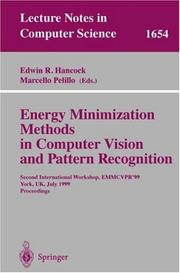
ISBN: 3540484329 3540662944 Year: 1999 Publisher: Berlin ; Heidelberg : Springer Verlag,
Abstract | Keywords | Export | Availability | Bookmark
 Loading...
Loading...Choose an application
- Reference Manager
- EndNote
- RefWorks (Direct export to RefWorks)
Computer vision --- Pattern recognition systems --- Neural networks (Computer science) --- Evolutionary computation --- Simulated annealing (Mathematics) --- Applied Physics --- Engineering & Applied Sciences --- Algorithm, Annealing --- Algorithm, Probabilistic exchange --- Annealing, Monte Carlo --- Annealing, Simulated --- Annealing algorithm --- Cooling, Statistical --- Exchange algorithm, Probabilistic --- Hill climbing, Probabilistic --- Monte Carlo annealing --- Probabilistic exchange algorithm --- Probabilistic hill climbing --- Relaxation, Stochastic --- Statistical cooling --- Stochastic relaxation --- Computer science. --- Computer logic. --- Image processing. --- Pattern recognition. --- Biomathematics. --- Statistical physics. --- Dynamical systems. --- Computer Science. --- Pattern Recognition. --- Image Processing and Computer Vision. --- Logics and Meanings of Programs. --- Statistical Physics, Dynamical Systems and Complexity. --- Mathematical and Computational Biology. --- Combinatorial optimization --- Optical pattern recognition. --- Computer vision. --- Logic design. --- Complex Systems. --- Statistical Physics and Dynamical Systems. --- Physics --- Mathematical statistics --- Design, Logic --- Design of logic systems --- Digital electronics --- Electronic circuit design --- Logic circuits --- Machine theory --- Switching theory --- Machine vision --- Vision, Computer --- Artificial intelligence --- Image processing --- Optical data processing --- Pattern perception --- Perceptrons --- Visual discrimination --- Statistical methods --- Optical data processing. --- Computer science logic --- Logic, Symbolic and mathematical --- Optical computing --- Visual data processing --- Bionics --- Electronic data processing --- Integrated optics --- Photonics --- Computers --- Design perception --- Pattern recognition --- Form perception --- Perception --- Figure-ground perception --- Biology --- Mathematics --- Dynamical systems --- Kinetics --- Mechanics, Analytic --- Force and energy --- Mechanics --- Statics --- Optical equipment
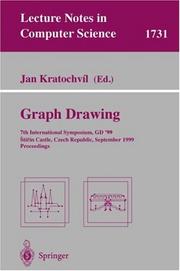
ISBN: 3540466487 3540669043 Year: 1999 Publisher: New York, NY ; Berlin : Springer-Verlag,
Abstract | Keywords | Export | Availability | Bookmark
 Loading...
Loading...Choose an application
- Reference Manager
- EndNote
- RefWorks (Direct export to RefWorks)
The range of issues considered in graph drawing includes algorithms, graph theory, geometry, topology, order theory, graphic languages, perception, app- cations, and practical systems. Much research is motivated by applications to systems for viewing and interacting with graphs. The interaction between th- retical advances and implemented solutions is an important part of the graph drawing eld. The annually organized graph drawing symposium is a forum for researchers, practitioners, developers, and users working on all aspects of graph visualization and representations. The preceding symposia were held in M- treal (GD’98), Rome (GD’97), Berkeley (GD’96), Passau (GD’95), Princeton (GD’94), and Paris (GD’93). The Seventh International Symposium on Graph Drawing GD’99 was or- nized at Sti r n Castle, in the vicinity of Prague, Czech Republic. This baroque castle recently restored as a hotel and conference center provided a secluded place for the participants, who made good use of the working atmosphere of the conference. In total the symposium had 83 registered participants from 16 countries.
Computer graphics --- Graph theory --- Technology - General --- Engineering & Applied Sciences --- Computer science. --- Algorithms. --- Computer science --- Computer graphics. --- Application software. --- Combinatorics. --- Computer Science. --- Computer Applications. --- Computer Graphics. --- Discrete Mathematics in Computer Science. --- Algorithm Analysis and Problem Complexity. --- Mathematics. --- Computational complexity. --- Computer software. --- Combinatorics --- Algebra --- Mathematical analysis --- Software, Computer --- Computer systems --- Complexity, Computational --- Electronic data processing --- Machine theory --- Automatic drafting --- Graphic data processing --- Graphics, Computer --- Computer art --- Graphic arts --- Engineering graphics --- Image processing --- Informatics --- Science --- Digital techniques --- Computer science—Mathematics. --- Application computer programs --- Application computer software --- Applications software --- Apps (Computer software) --- Computer software --- Algorism --- Arithmetic --- Foundations
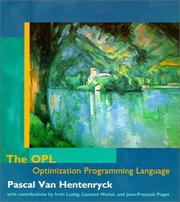
ISBN: 0262720302 9780262720304 Year: 1999 Publisher: Cambridge (Mass.): MIT Press,
Abstract | Keywords | Export | Availability | Bookmark
 Loading...
Loading...Choose an application
- Reference Manager
- EndNote
- RefWorks (Direct export to RefWorks)
OPL (computer program language) --- OPL (Computer program language) --- 681.3*D31 --- 681.3*D33 --- 681.3*G16 --- 681.3*G4 --- Optimization Programming Language (Computer program language) --- Programming languages (Electronic computers) --- Formal definitions and theory: semantics; syntax (Programming languages)--See also {681.3*D21}; {681.3*F31}; {681.3*F32}; {681.3*F42}; {681.3*F43} --- Languages constructs: abstract data types; concurrent programming structures;control structures; coroutines (Programming languages) --- Optimization: constrained optimization; gradient methods; integer programming; least squares methods; linear programming; nonlinear programming (Numericalanalysis) --- Mathematical software: algorithm analysis; certification and testing; efficiency; portability; reliability and robustness; verification --- 681.3*D31 Formal definitions and theory: semantics; syntax (Programming languages)--See also {681.3*D21}; {681.3*F31}; {681.3*F32}; {681.3*F42}; {681.3*F43} --- 681.3*G4 Mathematical software: algorithm analysis; certification and testing; efficiency; portability; reliability and robustness; verification --- 681.3*G16 Optimization: constrained optimization; gradient methods; integer programming; least squares methods; linear programming; nonlinear programming (Numericalanalysis) --- 681.3*D33 Languages constructs: abstract data types; concurrent programming structures;control structures; coroutines (Programming languages)
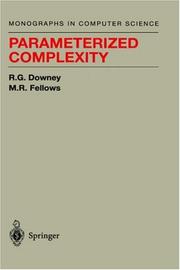
ISBN: 038794883X 1461267986 1461205158 Year: 1999 Publisher: New York (N.Y.) : Springer,
Abstract | Keywords | Export | Availability | Bookmark
 Loading...
Loading...Choose an application
- Reference Manager
- EndNote
- RefWorks (Direct export to RefWorks)
The idea for this book was conceived over the second bottle of Villa Maria's Caber net Medot '89, at the dinner of the Australasian Combinatorics Conference held at Palmerston North, New Zealand in December 1990, where the authors first met and discovered they had a number of interests in common. Initially, we embarked on a small project to try to formulate reductions to address the apparent parame terized intractability of DOMINATING SET, and to introduce a structure in which to frame our answers. Having spent several months trying to get the definitions for the reductions right (they now seem so obvious), we turned to our tattered copies of Garey and Johnson's work [239]. We were stunned to find that virtually none of the classical reductions worked in the parameterized setting. We then wondered if we'd be able to find any interesting reductions. Several years, many more bottles, so many papers, and reductions later it [3] seemed that we had unwittingly stumbled upon what we believe is a truly central and new area of complexity theory. It seemed to us that the material would be of great interest to people working in areas where exact algorithms for a small range of parameters are natural and useful (e. g. , Molecular Biology, VLSI design). The tractability theory was rich with distinctive and powerful techniques. The intractability theory seemed to have a deep structure and techniques all of its own.
Computer science --- Computational complexity. --- Complexité de calcul (Informatique) --- 511.3 --- Analytical, additive and other number-theory problems. Diophantine approximations --- 511.3 Analytical, additive and other number-theory problems. Diophantine approximations --- Complexité de calcul (Informatique) --- Computational complexity --- Complexity, Computational --- Electronic data processing --- Machine theory --- Computers. --- Mathematical logic. --- Applied mathematics. --- Engineering mathematics. --- Combinatorics. --- Algorithms. --- Theory of Computation. --- Mathematical Logic and Foundations. --- Applications of Mathematics. --- Algorithm Analysis and Problem Complexity. --- Algorism --- Algebra --- Arithmetic --- Combinatorics --- Mathematical analysis --- Engineering --- Engineering analysis --- Algebra of logic --- Logic, Universal --- Mathematical logic --- Symbolic and mathematical logic --- Symbolic logic --- Mathematics --- Algebra, Abstract --- Metamathematics --- Set theory --- Syllogism --- Automatic computers --- Automatic data processors --- Computer hardware --- Computing machines (Computers) --- Electronic brains --- Electronic calculating-machines --- Electronic computers --- Hardware, Computer --- Computer systems --- Cybernetics --- Calculators --- Cyberspace --- Foundations
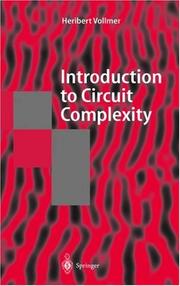
ISBN: 3540643109 3642083986 3662039273 Year: 1999 Publisher: Berlin Springer
Abstract | Keywords | Export | Availability | Bookmark
 Loading...
Loading...Choose an application
- Reference Manager
- EndNote
- RefWorks (Direct export to RefWorks)
This advanced textbook presents a broad and up-to-date view of the computational complexity theory of Boolean circuits. It combines the algorithmic and the computability-based approach, and includes extensive discussion of the literature to facilitate further study. It begins with efficient Boolean circuits for problems with high practical relevance, e.g., arithmetic operations, sorting, and transitive closure, then compares the computational model of Boolean circuits with other models such as Turing machines and parallel machines. Examination of the complexity of specific problems leads to the definition of complexity classes. The theory of circuit complexity classes is then thoroughly developed, including the theory of lower bounds and advanced topics such as connections to algebraic structures and to finite model theory.
Computer science --- Algebra, Boolean. --- Computational complexity. --- Electronic digital computers --- Logic, Symbolic and mathematical. --- Circuits --- Design. --- Computers. --- Algorithms. --- Mathematical logic. --- Computer mathematics. --- Electronics. --- Microelectronics. --- Theory of Computation. --- Computation by Abstract Devices. --- Algorithm Analysis and Problem Complexity. --- Mathematical Logic and Formal Languages. --- Computational Mathematics and Numerical Analysis. --- Electronics and Microelectronics, Instrumentation. --- Microminiature electronic equipment --- Microminiaturization (Electronics) --- Electronics --- Microtechnology --- Semiconductors --- Miniature electronic equipment --- Electrical engineering --- Physical sciences --- Computer mathematics --- Electronic data processing --- Mathematics --- Algebra of logic --- Logic, Universal --- Mathematical logic --- Symbolic and mathematical logic --- Symbolic logic --- Algebra, Abstract --- Metamathematics --- Set theory --- Syllogism --- Algorism --- Algebra --- Arithmetic --- Automatic computers --- Automatic data processors --- Computer hardware --- Computing machines (Computers) --- Electronic brains --- Electronic calculating-machines --- Electronic computers --- Hardware, Computer --- Computer systems --- Cybernetics --- Machine theory --- Calculators --- Cyberspace --- Foundations --- Automatic digital computers --- Computers, Electronic digital --- Digital computers, Electronic --- Computers --- Hybrid computers --- Sequential machine theory
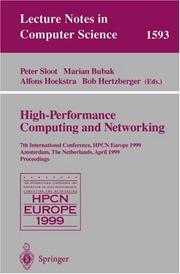
ISBN: 3540658211 3540489339 Year: 1999 Volume: 1593 Publisher: Berlin, Heidelberg : Springer Berlin Heidelberg : Imprint: Springer,
Abstract | Keywords | Export | Availability | Bookmark
 Loading...
Loading...Choose an application
- Reference Manager
- EndNote
- RefWorks (Direct export to RefWorks)
This book constitutes the refereed proceedings of the 7th International Conference on High-Performance Computing and Networking, HPCN Europe 1999, held in Amsterdam, The Netherlands in April 1999. The 115 revised full papers presented were carefully selected from a total of close to 200 conference submissions as well as from submissions for various topical workshops. Also included are 40 selected poster presentations. The conference papers are organized in three tracks: end-user applications of HPCN, computational science, and computer science; additionally there are six sections corresponding to topical workshops.
Computer Science --- Engineering & Applied Sciences --- Computer science. --- Computer communication systems. --- Software engineering. --- Computers. --- Algorithms. --- Computer science --- Computer mathematics. --- Computer Science. --- Software Engineering/Programming and Operating Systems. --- Computer Communication Networks. --- Theory of Computation. --- Mathematics of Computing. --- Algorithm Analysis and Problem Complexity. --- Computational Mathematics and Numerical Analysis. --- Mathematics. --- High performance computing --- Congresses --- Computer networks --- Information theory. --- Computer software. --- Software, Computer --- Computer systems --- Communication theory --- Communication --- Cybernetics --- Computer mathematics --- Discrete mathematics --- Electronic data processing --- Computer software engineering --- Engineering --- Informatics --- Science --- Mathematics --- Computer science—Mathematics. --- Algorism --- Algebra --- Arithmetic --- Automatic computers --- Automatic data processors --- Computer hardware --- Computing machines (Computers) --- Electronic brains --- Electronic calculating-machines --- Electronic computers --- Hardware, Computer --- Machine theory --- Calculators --- Cyberspace --- Communication systems, Computer --- Computer communication systems --- Data networks, Computer --- ECNs (Electronic communication networks) --- Electronic communication networks --- Networks, Computer --- Teleprocessing networks --- Data transmission systems --- Digital communications --- Electronic systems --- Information networks --- Telecommunication --- Cyberinfrastructure --- Network computers --- Foundations --- Distributed processing --- Computer networks.
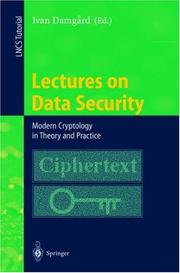
ISBN: 3540657576 354048969X Year: 1999 Volume: 1561 Publisher: Berlin ; Heidelberg : Springer,
Abstract | Keywords | Export | Availability | Bookmark
 Loading...
Loading...Choose an application
- Reference Manager
- EndNote
- RefWorks (Direct export to RefWorks)
Computer security --- Cryptography --- Sécurité informatique --- Cryptographie --- Computer Science --- Engineering & Applied Sciences --- Computer security. --- Cryptography. --- Sécurité informatique --- Cryptanalysis --- Cryptology --- Secret writing --- Steganography --- Computer privacy --- Computer system security --- Computer systems --- Computers --- Cyber security --- Cybersecurity --- Electronic digital computers --- Security of computer systems --- Security measures --- Protection of computer systems --- Protection --- Computer science. --- Computer communication systems. --- Operating systems (Computers). --- Data encryption (Computer science). --- Algorithms. --- Computer science --- Computer Science. --- Data Encryption. --- Algorithm Analysis and Problem Complexity. --- Operating Systems. --- Computer Communication Networks. --- Discrete Mathematics in Computer Science. --- Mathematics. --- Computer software. --- Computational complexity. --- Cryptology. --- Complexity, Computational --- Electronic data processing --- Machine theory --- Algorism --- Algebra --- Arithmetic --- Computer operating systems --- Disk operating systems --- Systems software --- Software, Computer --- Data encoding (Computer science) --- Encryption of data (Computer science) --- Foundations --- Operating systems --- Computer science—Mathematics. --- Communication systems, Computer --- Computer communication systems --- Data networks, Computer --- ECNs (Electronic communication networks) --- Electronic communication networks --- Networks, Computer --- Teleprocessing networks --- Data transmission systems --- Digital communications --- Electronic systems --- Information networks --- Telecommunication --- Cyberinfrastructure --- Network computers --- Distributed processing --- Operating systems (Computers) --- Informatics --- Science

ISBN: 354066226X 3540485198 Year: 1999 Volume: 1636 Publisher: Berlin ; New York : Springer,
Abstract | Keywords | Export | Availability | Bookmark
 Loading...
Loading...Choose an application
- Reference Manager
- EndNote
- RefWorks (Direct export to RefWorks)
Computers --- Ordinateurs --- Access control --- Passwords --- Congresses --- Accès --- Contrôle --- Mots de passe --- Congrès --- Computer Science --- Engineering & Applied Sciences --- Accès --- Contrôle --- Congrès --- Computer science. --- Computer programming. --- Data encryption (Computer science). --- Coding theory. --- Algorithms. --- Management information systems. --- Computer Science. --- Data Encryption. --- Programming Techniques. --- Algorithm Analysis and Problem Complexity. --- Coding and Information Theory. --- Management of Computing and Information Systems. --- Computer software. --- Information Systems. --- Cryptology. --- Software, Computer --- Computer systems --- Informatics --- Science --- Data encoding (Computer science) --- Encryption of data (Computer science) --- Computer security --- Cryptography --- Data compression (Telecommunication) --- Digital electronics --- Information theory --- Machine theory --- Signal theory (Telecommunication) --- Computer programming --- Algorism --- Algebra --- Arithmetic --- Foundations --- Information theory. --- Electronic computer programming --- Electronic data processing --- Electronic digital computers --- Programming (Electronic computers) --- Coding theory --- Computer-based information systems --- EIS (Information systems) --- Executive information systems --- MIS (Information systems) --- Sociotechnical systems --- Information resources management --- Management --- Communication theory --- Communication --- Cybernetics --- Programming --- Communication systems --- Contrôle. --- Contrôle.
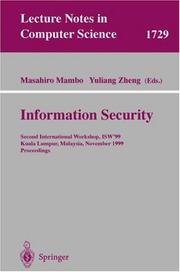
ISBN: 3540666958 354047790X Year: 1999 Volume: 1729 Publisher: Berlin ; Heidelberg : Springer,
Abstract | Keywords | Export | Availability | Bookmark
 Loading...
Loading...Choose an application
- Reference Manager
- EndNote
- RefWorks (Direct export to RefWorks)
Computer security --- Computers --- Sécurité informatique --- Congresses --- Access control --- Congrès --- Computer Science --- Engineering & Applied Sciences --- Sécurité informatique --- Congrès --- Computer science. --- Computer communication systems. --- Data encryption (Computer science). --- Algorithms. --- Computer science --- Management information systems. --- Computer Science. --- Data Encryption. --- Algorithm Analysis and Problem Complexity. --- Discrete Mathematics in Computer Science. --- Computer Communication Networks. --- Management of Computing and Information Systems. --- Mathematics. --- Computer software. --- Computational complexity. --- Information Systems. --- Cryptology. --- Complexity, Computational --- Electronic data processing --- Machine theory --- Software, Computer --- Computer systems --- Data encoding (Computer science) --- Encryption of data (Computer science) --- Cryptography --- Computer science—Mathematics. --- Informatics --- Science --- Computer-based information systems --- EIS (Information systems) --- Executive information systems --- MIS (Information systems) --- Sociotechnical systems --- Information resources management --- Management --- Communication systems, Computer --- Computer communication systems --- Data networks, Computer --- ECNs (Electronic communication networks) --- Electronic communication networks --- Networks, Computer --- Teleprocessing networks --- Data transmission systems --- Digital communications --- Electronic systems --- Information networks --- Telecommunication --- Cyberinfrastructure --- Network computers --- Algorism --- Algebra --- Arithmetic --- Communication systems --- Distributed processing --- Foundations
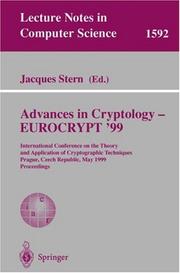
ISSN: 03029743 ISBN: 3540658890 9783540658894 354048910X Year: 1999 Volume: 1592 Publisher: Berlin: Springer,
Abstract | Keywords | Export | Availability | Bookmark
 Loading...
Loading...Choose an application
- Reference Manager
- EndNote
- RefWorks (Direct export to RefWorks)
Cryptography --- Data encryption (Computer science) --- Cryptographie --- Chiffrement (Informatique) --- Congresses --- Congrès --- Computer science. --- Computer communication systems. --- Data encryption (Computer science). --- Algorithms. --- Computer science --- Computer mathematics. --- Computer Science. --- Data Encryption. --- Discrete Mathematics in Computer Science. --- Algorithm Analysis and Problem Complexity. --- Computer Communication Networks. --- Computational Mathematics and Numerical Analysis. --- Mathematics. --- Computer security --- Congrès --- Computational complexity. --- Computer software. --- Cryptology. --- Computer mathematics --- Discrete mathematics --- Electronic data processing --- Software, Computer --- Computer systems --- Complexity, Computational --- Machine theory --- Data encoding (Computer science) --- Encryption of data (Computer science) --- Mathematics --- Computer science—Mathematics. --- Communication systems, Computer --- Computer communication systems --- Data networks, Computer --- ECNs (Electronic communication networks) --- Electronic communication networks --- Networks, Computer --- Teleprocessing networks --- Data transmission systems --- Digital communications --- Electronic systems --- Information networks --- Telecommunication --- Cyberinfrastructure --- Network computers --- Algorism --- Algebra --- Arithmetic --- Distributed processing --- Foundations --- Computer networks. --- Informatics --- Science --- Cryptography - Congresses --- Data encryption (Computer science) - Congresses
| Listing 1 - 10 of 44 | << page >> |
Sort by
|

 Search
Search Feedback
Feedback About UniCat
About UniCat  Help
Help News
News